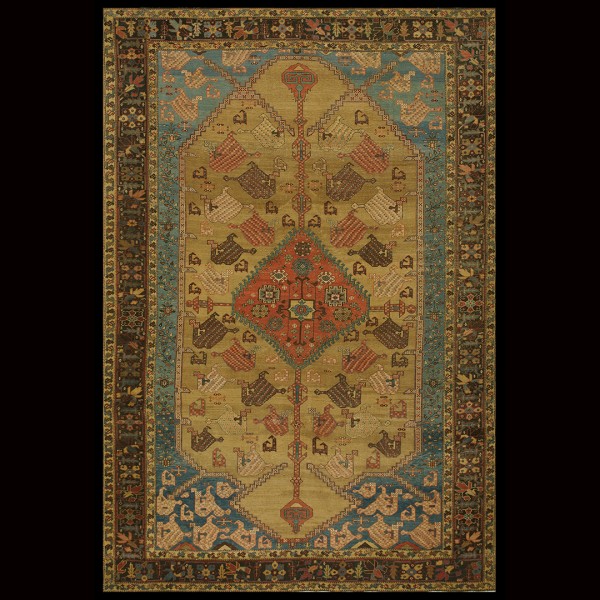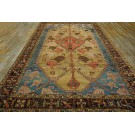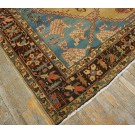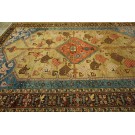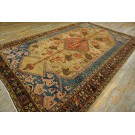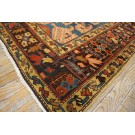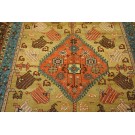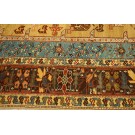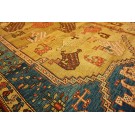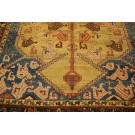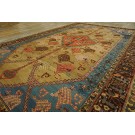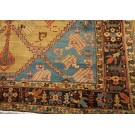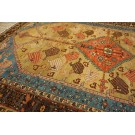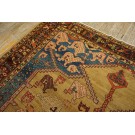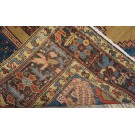19th Century N.W. Persian Bakshaiesh Carpet
A large, light brown ground shield shape approximated to the hexagon is delimited from the blue-ground field by a ribbon filled with five cubes and stepped in the diagonals. It contains a massive, grid-shaped medallion with long projections in the vertical and horizontal axes. The shield shape, reminiscent of animal fur carpets, is filled with a memorable motif of a shelf-like contour that bears a sickle shape, as well as with smaller animals, two human figures and bleeding. The corners seem to show the catchy motif of the shield shape enlarged in a cutout.
The color combination of light brown and blue, the rather coarse setting and the soft feel compared to other carpets from the Heris area despite the use of cotton in warp and weft is typical of a group of old Bakshaiesh carpets. A copy in this color scheme published by Schurmann 1976, p. 115 and classified around 1800 shows archaic dragons in the field and corners, which are explained by the proximity of the Caucasus. Dragon drawings are not specifically Caucasian. Based on the assumption that due to the drawing of the above-mentioned comparative piece and the shield shape reminiscent of animal fur carpets (cf. No. 7), this carpet is also about extremely stylized, simplified animal shapes, early Turkic animal carpets should also be used for an interpretation. A carpet from the 15th century shows animals in rows (see Yetkin 1981, plate 20), another a couple on a tree (see Yetkin loc. Cit., Plate 17). The animals in the latter carpet carry a number of characteristic, sickle-shaped "C" motifs, as they also occur in the large, stylized forms of the present carpet. The sickle shapes characterize animals.
The depiction of two figures dressed differently can indicate that the carpet has a special occasion, e.g. a wedding was made. Due to a stylistic comparison of the borders and the strongly stylized motifs, the carpet was created in the middle of the 19th century.
The color combination of light brown and blue, the rather coarse setting and the soft feel compared to other carpets from the Heris area despite the use of cotton in warp and weft is typical of a group of old Bakshaiesh carpets. A copy in this color scheme published by Schurmann 1976, p. 115 and classified around 1800 shows archaic dragons in the field and corners, which are explained by the proximity of the Caucasus. Dragon drawings are not specifically Caucasian. Based on the assumption that due to the drawing of the above-mentioned comparative piece and the shield shape reminiscent of animal fur carpets (cf. No. 7), this carpet is also about extremely stylized, simplified animal shapes, early Turkic animal carpets should also be used for an interpretation. A carpet from the 15th century shows animals in rows (see Yetkin 1981, plate 20), another a couple on a tree (see Yetkin loc. Cit., Plate 17). The animals in the latter carpet carry a number of characteristic, sickle-shaped "C" motifs, as they also occur in the large, stylized forms of the present carpet. The sickle shapes characterize animals.
The depiction of two figures dressed differently can indicate that the carpet has a special occasion, e.g. a wedding was made. Due to a stylistic comparison of the borders and the strongly stylized motifs, the carpet was created in the middle of the 19th century.
| Stock ID: | #22410 |
| General Rug Type: | Persian Informal |
| Specific Rug Type: | Bakshaiesh |
| Circa: | 1870 |
| Ground Color: | Camel |
| Border Color: | Black |
| Origin: | Persia |
| Material: | Wool |
| Weave: | Pile - Knotted |
| Shape: | Rectangle |
| Width: | 7' 6" ( 229 cm ) |
| Length: | 11' 4" ( 345 cm ) |
| Tearsheet Download |
